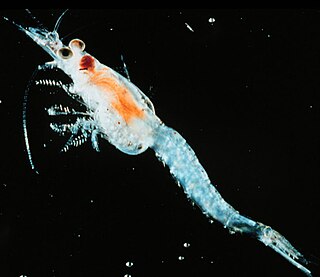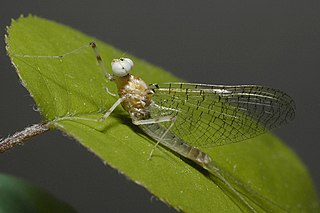
Branchiopoda is a class of crustaceans. It comprises fairy shrimp, clam shrimp, Diplostraca, Notostraca and the Devonian Lepidocaris. They are mostly small, freshwater animals that feed on plankton and detritus.

The order Notostraca, containing the single family Triopsidae, is a group of crustaceans known as tadpole shrimp or shield shrimp. The two genera, Triops and Lepidurus, are considered living fossils, with similar forms having existed since the end of the Devonian, around 360 million years ago. They have a broad, flat carapace, which conceals the head and bears a single pair of compound eyes. The abdomen is long, appears to be segmented and bears numerous pairs of flattened legs. The telson is flanked by a pair of long, thin caudal rami. Phenotypic plasticity within taxa makes species-level identification difficult, and is further compounded by variation in the mode of reproduction. Notostracans are omnivores living on the bottom of temporary pools and shallow lakes.

Anostraca is one of the four orders of crustaceans in the class Branchiopoda; its members are referred to as fairy shrimp. They live in vernal pools and hypersaline lakes across the world, and they have even been found in deserts, ice-covered mountain lakes, and Antarctic ice. They are usually 6–25 mm (0.24–0.98 in) long. Most species have 20 body segments, bearing 11 pairs of leaf-like phyllopodia, and the body lacks a carapace. They swim "upside-down" and feed by filtering organic particles from the water or by scraping algae from surfaces, with the exception of Branchinecta gigas, or "giant fairy shrimp", which is itself a predator of other species of anostracans. They are an important food for many birds and fish, and some are cultured and harvested for use as fish food. There are 300 species spread across 8 families.

Prof Georg Ossian Sars HFRSE was a Norwegian marine and freshwater biologist.

Mysis is a genus of mysid crustaceans in the family Mysidae, distributed mainly in the coastal zone of the Arctic and high boreal seas. Several species also inhabit northern freshwater lakes and the brackish Caspian Sea. Fifteen species are recognized. Body lengths range from 1 to 3 centimetres.

Branchinecta is a genus of crustacean in family Branchinectidae. It includes around 50 species, found on all continents except Australia. Branchinecta gigas, the giant fairy shrimp, is the largest species in the order, with a length of up to 10 centimetres (4 in), and Branchinecta brushi lives at the highest altitude of any crustacean, at 5,930 metres (19,460 ft), a record it shares with the copepod Boeckella palustris. A new genus, Archaebranchinecta was established in 2011 for two species previously placed in Branchinecta.

The Diplostraca or Cladocera, commonly known as water fleas, is a superorder of small, mostly freshwater crustaceans, most of which feed on microscopic chunks of organic matter, though some forms are predatory.

Leptodora is a genus containing two species of large, nearly transparent predatory water fleas. They grow up to 21 mm (0.83 in) long, with two large antennae used for swimming and a single compound eye. The legs are used to catch copepods that it comes into contact with by chance. Leptodora kindtii is found in temperate lakes across the Northern Hemisphere and is probably the only water flea species ever described in a newspaper; L. richardi is only known from eastern Russia. For most of the year, Leptodora reproduces parthenogenetically, with males only appearing late in the season, to produce winter eggs which hatch the following spring. Leptodora is the only genus in its family, the Leptodoridae, and suborder, Haplopoda.

Cyprididae is "the most diverse group of freshwater ostracods". It contains over 1000 species, which represents 50% of the known species of freshwater ostracods. Around 60% of genera in the family are endemic to a single zoogeographic region. The family contains 16 subfamilies, and is most diverse in the Afrotropical realm, with over 300 species in 45 genera. Many Cyprididae occur in temporary water bodies and have drought-resistant eggs, mixed/parthenogenetic reproduction and ability to swim. These biological attributes pre-adapt them to form successful radiations in these habitats. Bennelongia is an interesting of the family Cyprididae. It may be the last true descendant of the Mesozoic lineage of Cypridea, which was a dominant lineage of ostracod in non-marine waters in the Cretaceous.

Sida is a genus of ctenopods in the family Sididae. There are about five described species in Sida.

Bosminidae is a family of anomopods in the order Diplostraca. There are at least 3 genera and 40 described species in Bosminidae.
Cactus is a genus of anomopods in the family Macrothricidae. There is only one described species, Cactus cactus. C. cactus can be found in Chile.

Podonidae is a family of onychopods in the order Diplostraca. There are about 8 genera and at least 20 described species in Podonidae. A lot of them are non-native species, many of which pose a great threat to aquatic ecosystems.

Evadne is a genus of onychopods in the family Podonidae. There are at least four described species in Evadne.

Isonychia is a genus of brushlegged mayflies in the family Isonychiidae, the sole genus of the family. There are more than 30 described species in Isonychia.
Plauditus is a genus of small minnow mayflies in the family Baetidae. There are about 10 described species in Plauditus.

Maccaffertium is a genus of flatheaded mayflies in the family Heptageniidae. There are at least 20 described species in Maccaffertium.

Podon is a genus of onychopods in the family Podonidae. There are at least four described species in Podon.

Chydoridae is a family of water fleas in the order Anomopoda. There are more than 50 genera and 520 described species in Chydoridae. A lot of Chydoridae species are non-native species, many of which pose a great threat to aquatic ecosystems.
Iphigenellidae is a freshwater family of amphipods in the superfamily Gammaroidea. It is found in the Ponto-Caspian region, which encompasses the Black, Azov, and Caspian Seas.


















